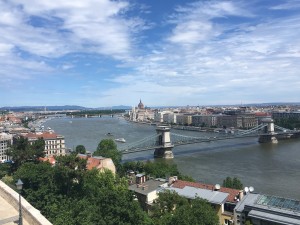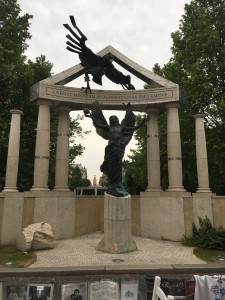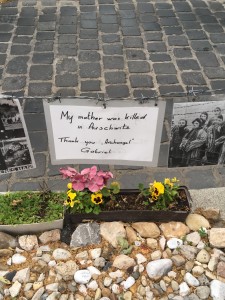Today was my first day of classes! I am very excited to begin my life as a student in the Budapest Semesters in Mathematics program. It’s actually not too different from living at school. Except the language… and customs…… people ……… currency……….. most things……… there’s no water fountains in any of the buildings? ……………..
While this is very exciting, I want to use this first post, and generally my section of this blog to advise any UPS students who may want to study abroad in Europe, and especially in Budapest, with either in the AIT computer science program, or the mathematics program. In particular I want to discuss public transportation.
Public transit has always fascinated me. I always wonder about the relationship between the economy of a city or a country, and the quality of the public transit system. I will not be discussing any of these questions, nor have I done any research… Instead, I will talk about the practical realities of using public transportation in Europe.
Public transportation can be scary for people who aren’t used to it. The rush hour crowds, the stress of running late. Especially if everything is in a different language, it can be extremely confusing, and difficult to ask directions. But public transportation can be a vital part of your time abroad in Europe.
For people who are used to taking lots of trains or buses, the information in this post may all be familiar. But for people who aren’t used to using public transit, there can be a learning curve; not just in learning the different train lines, but with actually getting used to the large number of complete strangers you may have to be uncomfortably close to.
First, a little background on why I am a big fan of public transit. (Two big reasons are that cars are evil metal killing machines, and public transit is much better for the environment, but those are secondary.) The main reason is my personal reliance on public transit. I live in Oakland, but I went to high school in San Francisco. For those (few) UPS students who are not from the bay area, these are two adjacent cities, and this required me to take a train and a bus nearly every morning for four years. As a result, I had some sort of odd Stockholm syndrome attachment to the San Fransisco public bus and tram system (MUNI, as in municipal transportation), and thought it was amazing. Especially since the public transit systems in many of the neighboring cities and other places I have been to are terrible (I mean, Sound Transit is nice, but you know). The only public transit better than MUNI that I had seen were the Portland street cars, or so I thought. But after visiting Europe for a few weeks, I realized that most public transit in the US is total garbage somewhat lacking in comparison.
My parents used my semester abroad as an excuse to plan a short tour of Europe. As a result, I got to see first-hand several public transit systems. London, famously has the underground, which was pretty remarkable (except for all of the stairs). In Amsterdam, they have something similar to Portland street cars. Unlike Portland however, the longest I ever waited for a train was 6 minutes. Paris also has a great underground metro system. In San Francisco on the other hand, I remember waiting for the 44 (a MUNI bus) for 44 minutes, and laughing at the irony. Of course, I was also pretty pissed.
But anyway, here are the major similarities between good public transit systems:
- All of the train or metro lines are color coded as well as numbered and named. This seems to be a very universal system for public transit systems, even in the US.
- The name of a train or metro line almost always refers to the first and last stops the train makes. This gives you just enough information to uniquely determine which stops you can get to from your current station or stop. e.g. If I need to take the red line toward Déli pályaudvar, this tell me that this train will stop at all of the stops along the red line in the direction of Déli pályaudvar.
- Often a single public transit system will include multiple modes of transportation, for example buses and trams. In this case, the name of a line will often indicate the mode of transport. Here in Budapest, the red line toward Déli pályaudvar, is actually the M2, as in the second Metro line towards Déli pályaudvar. This reduces confusion since there is also a number 2 tram or street car line. But these have different stop names, and are yellow lines.
Remember, Google Maps is your friend! Occasionally the names of the stop will be partially in English, and it can be quite stressful when the name almost matches the name on your phone, but not quite. It’s ok, Google is just trying to be helpful and instead is giving you terrible anxiety.
But, remember Google is based in California. As a result, they have a very good grasp of public transit in the United States, including places to transfer. In Budapest, however, there are so many different options (bus, tram, train, cable car, boat(!?)) that Google maps simply cannot always give a good route to your destination. If you have some free time, especially if it’s a weekday say around 11am or 2pm, take some time to just ride around to different places. explore the different systems. I was lucky to have around a week to get used to the city and its public transportation. Since my parents were staying at a hotel, and I already had an apartment, this was a good excuse for me to take the public transit system back and forth. After a while, I started to notice that Google maps was not actually giving me the best route. Or even a good one. For example it might suggest taking a train, but then getting off and taking a long bus ride, when I knew for a fact that I could just transfer from the M2 line to the M4 line.
While the naming convention is nice and is an easy way to uniquely determine which direction a train is headed, it often doesn’t actually help. Usually I have no idea if the station I am trying to get to is in one direction or the other. Instead, I recommend looking up (if you can) which station is right after the station you are currently in. But otherwise, there should be a (clearly labeled) map, usually only showing the lines which stop at your current station.
Here are some other things to keep in mind about buying tickets:
- The ticket vending stations almost always have an option for English. If you don’t see the word “English”, you will see different country flags. Occasionally you will see a US flag, but usually you will see a British flag (which, by the way looks like this).
- You will probably be encouraged to do this by your program, but buying a monthly pass (if available) is always going to be a better option than buying a new ticket each time. This is strangely not always true in the US.
- Make sure you look understand how to actually use your ticket. Most underground train systems have an electronic gate. So you either scan or insert your ticket into a slot, and you are allowed to enter. If you insert the ticket into a slot, you usually have to take the ticket with you onto the train. However, on buses, trams, or street cars, you may simply scan the ticket once you get on. Often you do not have to show your ticket to a person. Instead, you are required to have the ticket on you at all times on the off chance that a ticket inspector shows up. Not having your ticket, or having an invalid ticket will lead to a fine.
One thing to note about the last bullet point. In Budapest almost all of this is different. If you buy a single use ticket, on every mode of transport, there is a little machine with a slot to “validate” your ticket. However, if you get the recommended monthly pass, you don’t need to do any of this. Instead, you simply always carry your pass and some form of picture ID on you with a number associated. Your school ID for example. When you buy the monthly pass, you will enter your ID number, say your school ID, and this number is printed onto the ticket. Then, on most modes of transport, you simply carry your pass and ID on you, ready to prove to the ticket inspectors that you did in fact buy this monthly pass. The one very odd exception are the metro lines. At every staircase or escalator, there will be a few people in uniform standing around. You then simply flash your pass to them and they let you by. That’s right, there is no physical barrier to the underground train system. This is the only system I have every seem like this.
I really believe that, while it can be terribly confusing at first, getting a good grasp of the public transport system is very liberating. Instead of always taking the same few routes, being able to get around the city without staring at your phone gives a nice safety net and a wonderful opportunity to explore places you otherwise might not have thought to.



